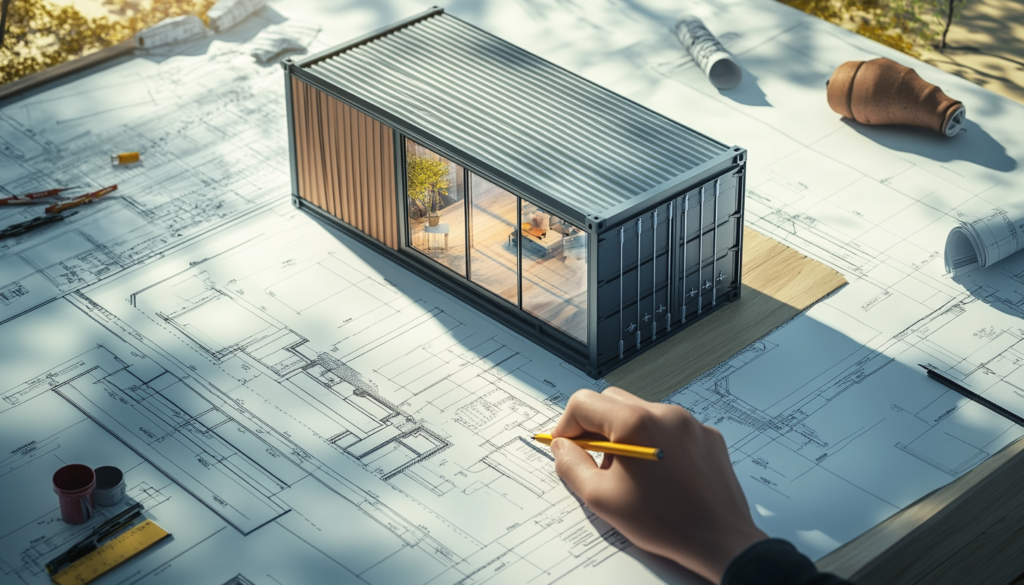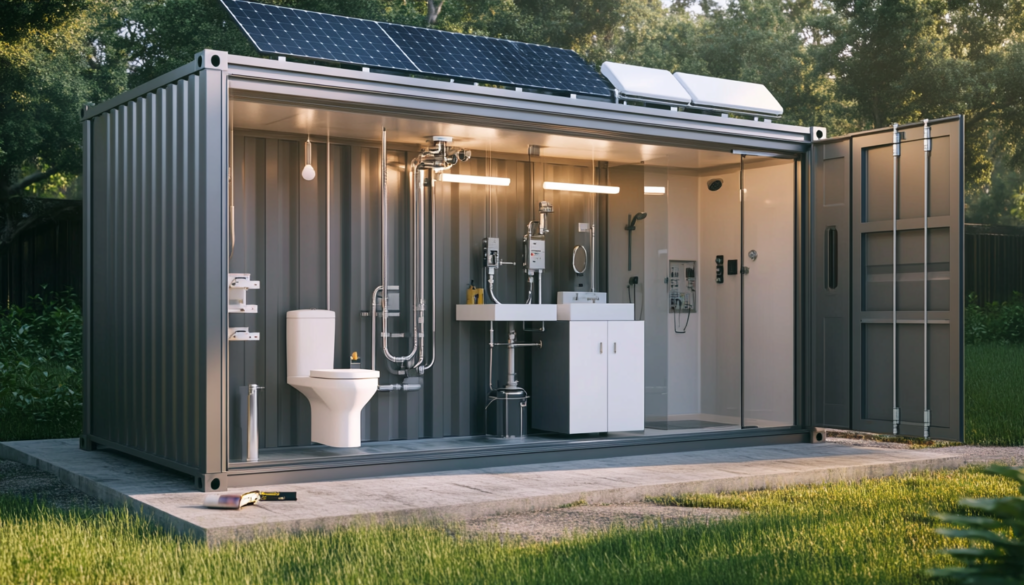The trend of turning shipping containers into homes is growing in popularity. It's key to learn from those who have already built them. This article shares lessons from experienced builders. It aims to help future builders and inspire others to try this unique way of living.Key TakeawaysThe Rise of Shipping Container HomesShipping container homes are becoming …
The trend of turning shipping containers into homes is growing in popularity. It’s key to learn from those who have already built them. This article shares lessons from experienced builders. It aims to help future builders and inspire others to try this unique way of living.

Key Takeaways
- Navigating zoning regulations and building codes is crucial when planning a shipping container home project.
- Sourcing and preparing the right containers can significantly impact the overall cost and feasibility of the build.
- Ensuring proper insulation and energy efficiency is vital for maintaining comfortable living conditions.
- Adapting existing plumbing and electrical systems to the unique layout of a container home requires careful planning.
- Structural reinforcement and addressing moisture-related issues are essential for the long-term durability and safety of a container home.
The Rise of Shipping Container Homes
Shipping container homes are becoming more popular. They are loved for being eco-friendly and affordable to build. These homes use repurposed steel containers to make unique, sustainable houses.
Eco-Friendly and Cost-Effective Construction
Shipping container homes are great for the planet. They use old containers, cutting down on the need for new materials. This reduces harm to the environment and lowers carbon emissions. Plus, containers are strong and can stand up to the weather, making them a budget-friendly choice.
Unique Architectural Possibilities
Shipping containers open up new ideas for home design. Architects and builders love to turn these boxes into stylish homes. They can make everything from modern to quirky designs. Shipping container home trends are changing what we think about container home design and container home architecture.
| Key Factors | Advantages |
|---|---|
| Eco-friendly construction | Reduced environmental impact, lower carbon footprint |
| Cost-effective solution | Significantly lower construction costs compared to traditional methods |
| Unique architectural design | Versatile and innovative living spaces that defy conventional norms |
“Shipping container homes represent a paradigm shift in the way we think about sustainable and cost-effective housing. They offer a unique canvas for architects and homeowners to create truly remarkable living spaces.”
Planning Your Shipping Container Home
Building a shipping container home needs careful planning and following local rules. It’s key to know the zoning laws and building codes to make sure your project is legal and goes smoothly.
Zoning Regulations and Building Codes
Before starting your shipping container home project, learn about the zoning laws and building codes in your area. These rules change a lot from place to place. So, it’s important to check what’s needed in your area.
Some important things to think about when planning your shipping container home include:
- Zoning Approval: Make sure your home’s location is okay for living and meets all the container home rules. This means looking at things like lot size, distance from neighbors, and how tall it can be.
- Building Permits: Get the needed building permits before you start building. You might need to send in detailed plans, structural info, and engineering reports.
- Safety Standards: Your shipping container home must follow all safety rules. This includes fire safety, electrical and plumbing codes, and making sure it’s easy for everyone to get in and out.
- Legal Considerations: Look into any laws or rules about using shipping containers as homes in your area.
By taking the time to understand shipping container home planning, container home zoning, container home building codes, and container home legal requirements, you can make sure your project is done right and follows the law.

“Proper planning and research are the keys to a successful shipping container home project. Failing to address zoning and building code requirements can lead to costly delays or even the complete abandonment of your dream.”
Sourcing and Preparing Shipping Containers
Finding the right sourcing shipping containers and getting them ready for a home is key. Homeowners need to check the condition, size, and what changes they need to make. This turns them into homes.
Choosing the right container home supply is crucial. Look for containers that are in good shape, without big dents or rust, and well taken care of. Think about size, how much it can hold, and any changes it might have had before.
- Check the container for any damages or wear and tear.
- Make sure it fits your design plans by measuring it.
- See if the container needs more support or changes.
- Look into the container’s history to make sure it’s safe for a home.
Getting your container home ready might mean removing harmful materials, insulating it, and putting in utilities. Planning well and paying attention to details makes the changes smoother. This turns a shipping container into a cozy home.
“Sourcing the right shipping containers is the foundation of a successful container home project. Take the time to thoroughly inspect and prepare them for residential use.”
By focusing on sourcing shipping containers and container home supply, you can start a rewarding container home refurbishment project. You’ll end up with a unique, eco-friendly home.
Insulation and Energy Efficiency Challenges
Building an energy-efficient shipping container home needs careful thought on insulation and climate control. These homes have unique challenges due to their small spaces. They require creative solutions to stay comfortable.
Regulating Temperature and Airflow
Container home insulation is key for keeping temperatures steady and living spaces comfy. Containers can swing wildly in temperature because they’re made of metal. So, picking the right insulation materials and methods is a must to keep the climate inside stable.
For container home temperature regulation, a mix of top-notch insulation, smart ventilation, and efficient heating and cooling is often used. Designers must find a balance between keeping the home warm or cool and saving energy.
Controlling Humidity and Condensation
Managing humidity is also vital in container home climate control. Too much moisture can cause mold and mildew, which is bad for health. Using good ventilation and dehumidifiers can keep humidity in check and stop condensation.
By tackling insulation and energy efficiency, builders can make container homes cozy and functional. They blend the benefits of modular building with the comforts of a regular home.

Plumbing and Electrical Considerations
Adding plumbing and electrical systems to container homes needs a lot of planning and special skills. It’s important to adjust existing systems to fit the unique needs of container homes. This ensures these systems work well and safely.
Adapting Existing Systems
For container home plumbing, you might need to make some changes. This could mean changing the water lines, drainage, and fixtures to use space wisely. Experts in plumbing can help make sure the plumbing is up to code and safe.
For container home electrical, you might need special solutions. You might need to place electrical panels and outlets carefully to use space well and keep things safe. Electricians can help make container home system adaptations that fit your needs and follow the rules.
| Feature | Plumbing Considerations | Electrical Considerations |
|---|---|---|
| Space Constraints | Compact design, strategic placement of fixtures | Efficient layout of electrical panels, outlets, and wiring |
| Building Codes | Compliance with local regulations for water supply and drainage | Meeting safety standards for electrical systems |
| Energy Efficiency | Water-saving fixtures and systems | Energy-efficient appliances and lighting |
By carefully planning plumbing and electrical systems, container home owners can make a living space that works well. It meets their needs and follows the rules for safety and building codes.

Shipping Container Homes: Hard-Learned Lessons from Those Who’ve Done It
Building a container home is a unique and rewarding experience, but it comes with challenges. We can learn from those who have already built their dream homes. They share their real-life stories and insights on how to succeed.
One key lesson is the need for thorough planning and research. “Before we started, we spent months studying building codes, zoning regulations, and the specific requirements for container home construction,” says Jane Doe from Los Angeles. “This upfront work helped us avoid costly delays and ensure our project aligned with local guidelines.”
Another important lesson is how to tackle insulation and energy efficiency. Sarah Smith, a homeowner in Seattle, shares, “Maintaining comfortable living conditions inside our container home required a thoughtful approach to insulation and ventilation. We had to experiment with different materials and techniques to find the right balance.”
| Container Home Challenges | Lessons Learned |
|---|---|
| Navigating Zoning Regulations | Thoroughly research local building codes and guidelines before starting construction |
| Ensuring Adequate Insulation and Ventilation | Experiment with different materials and techniques to achieve optimal energy efficiency |
| Adapting Plumbing and Electrical Systems | Plan for the integration of existing utilities and be prepared to make necessary modifications |
Container home owners also had to figure out plumbing and electrical systems. “We quickly learned that adapting traditional utilities to a container home required some creative problem-solving,” says Tom Wilson from Austin. “Being flexible and willing to make adjustments was key to ensuring our home was fully functional and livable.”
Despite the challenges, these homeowners have achieved great success. Their lessons offer valuable advice for those starting their own container home projects. They make the journey smoother and more rewarding.
Interior Design and Space Optimization
Designing the inside of a container home and making the most of the space is a challenge. Yet, owners have found smart ways to make their homes both useful and beautiful. They use every inch of space wisely.
Creative Solutions for Compact Living
Maximizing space is a big part of container home interior design. Owners use smart container home space planning to turn small spaces into cozy homes. They use furniture that changes shape, built-in storage, and rooms that do more than one thing. This makes container home space optimization an art.
- Use vertical space with lofted beds, overhead storage, and wall-mounted shelves
- Choose furniture that changes, like Murphy beds and convertible sofas
- Make rooms that work for living, dining, and sleeping
- Plan layouts that can change easily
By using container home compact living ideas, owners can make their homes look modern and efficient. They make the most of every inch of space.
| Interior Design Element | Description | Benefits |
|---|---|---|
| Lofted Beds | Beds that are up high to save floor space | Uses space well, adds storage underneath |
| Transformable Furniture | Furniture that changes its use, like Murphy beds and convertible sofas | Offers flexibility and more than one use for space |
| Multi-Purpose Rooms | Rooms that have more than one use, like for living, dining, and sleeping | Makes the most of space, keeps things open and connected |
“The key to successful container home interior design is finding creative ways to make the most of every square inch. It’s about being resourceful, adaptable, and always thinking outside the box.”
Structural Reinforcement and Safety
Building a shipping container home means making sure it’s safe and strong. Owners need to think about how to make it sturdy and secure. This ensures a reliable place to live.
Shipping containers are tough for moving, but they might not be strong enough for a house. Container home structural integrity is key. It’s fixed with special reinforcement and building methods.
To make a container home safe, owners should talk to experts. They’ll look at the project’s special needs. This might mean adding more steel, making the walls stronger, and checking the foundation can hold the house up.
- Check what container home construction reinforcement is needed for strength
- Get advice from pros to handle container home structural considerations for your project
- Focus on safety and stability for a secure home
By making the containers strong, people can live in them safely and save money. With good planning and expert advice, these unique homes can be very safe and strong.
Dealing with Moisture and Condensation
Keeping a shipping container home in good shape means paying close attention to moisture and condensation. It’s important to use proper ventilation, insulation, and dehumidification. These steps help stop mold and mildew from growing, which can harm the home’s health and lifespan.
Preventing Mold and Mildew Growth
It’s key to tackle moisture at its source to protect the container home. Homeowners should put in top-notch vapor barriers and make sure insulation is enough. They should also use good ventilation systems to keep humidity levels in check.
Checking regularly and taking action early can stop problems before they get worse. This keeps the home’s structure strong and the people living there healthy.
Using strong dehumidifiers and air fans can also help fight moisture issues. With these steps, shipping container owners can make a cozy, mold-free home that lasts.
FAQ
What are the eco-friendly and cost-effective benefits of shipping container homes?
Shipping container homes are gaining popularity for their green construction and cost savings. They use recycled containers, cutting down on waste and the need for new materials. Plus, their modular design can save money compared to traditional building.
What unique architectural possibilities do shipping container homes offer?
Shipping container homes let homeowners try out unique designs. They can make custom spaces that fit their style and needs. From modern to rustic, the design options are endless, making each home special.
What are the key zoning regulations and building codes to consider when planning a shipping container home?
It’s important to know the zoning laws and building codes for container homes. Homeowners need to check local rules to get approval and meet legal standards. This includes rules on setbacks, height, and permits for non-standard buildings.
How can homeowners ensure proper insulation and energy efficiency in their shipping container homes?
Keeping shipping container homes comfortable requires smart insulation and energy use. Choosing the right insulation materials is key. Using energy-efficient systems and sustainable designs also helps keep homes cozy and eco-friendly.
What are the key considerations for integrating plumbing and electrical systems into a shipping container home?
Adding plumbing and electrical systems to container homes needs careful planning. Homeowners should work with experts to ensure everything works well and safely. This might mean custom setups, alternative power sources, and careful wiring and piping.
How can homeowners optimize space and design creative interior solutions for their compact shipping container homes?
Designing a shipping container home requires smart use of space. Owners use multi-use furniture and clever storage to make the most of their space. Natural light and open layouts also help make the space feel bigger.
What are the key considerations for ensuring the structural integrity and safety of a shipping container home?
Keeping a shipping container home safe and strong is crucial. Homeowners should think about reinforcement and support to make a secure home. This might mean adding steel frames, strategic openings, and special anchoring systems.
How can homeowners effectively manage moisture and condensation in their shipping container homes to prevent mold and mildew growth?
Dealing with moisture and condensation is a big challenge for container homes. Good ventilation, insulation, and dehumidification are key to stop mold and mildew. This can include ventilation systems, moisture-resistant materials, and humidity control.













